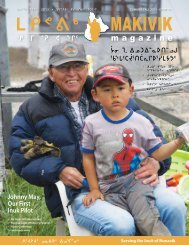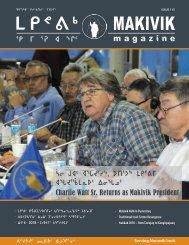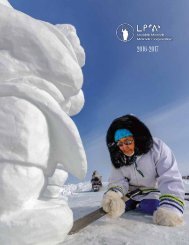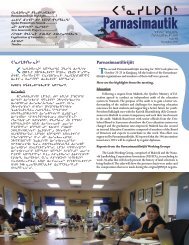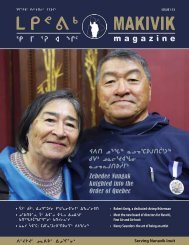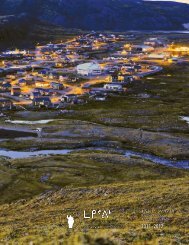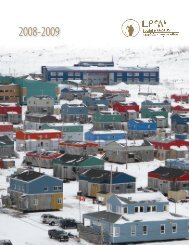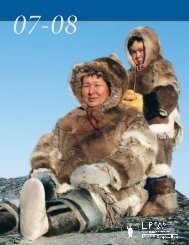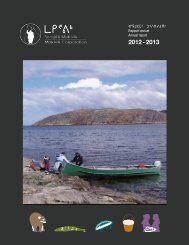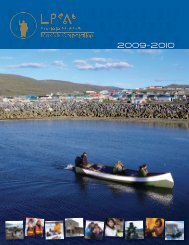2013-2014 Makivik Annual Report
The 2014 Makivik Annual Report
The 2014 Makivik Annual Report
You also want an ePaper? Increase the reach of your titles
YUMPU automatically turns print PDFs into web optimized ePapers that Google loves.
omega 3 fatty acids-ᖑᓂᕋᕐᑕᐅᔪᓂᒃ. ᕿᓚᓗᒐᕕᓃᑦ ᒪᑦᑕᖏᑦ<br />
ᓇᑦᓰᓗ ᓂᕐᐱᖏᑦ ᐱᑕᖃᕐᑐᑦ ᒥᑭᔪᐊᐱᓐᓂᒃ ᐊᑯᓐᓂᒦᑦᑐᓂᓪᓗ<br />
ᒨᑯᔨᑖᕐᓯᒪᒍᑎᓂᒃ. ᕿᓚᓗᒐᕕᓂᐅᑉ ᒪᑦᑕᖓ ᐱᑕᖃᒻᒪᕆᒻᒪᑦ selenium/<br />
ᓯᓖᓂᐋᒻᒥᒃ ᓂᕿᑦᓯᐊᓚᕆᐅᒍᑎᖃᕐᓱᓂᓗ ᐅᕐᓱᒥᒃ omega-3 fatty<br />
acid-ᖑᓂᕋᕐᑕᐅᔪᒥᒃ ᐱᑕᖃᑦᓯᐊᓱᓂᓗᑦᑕᐅᖅ ᓄᒃᑭᓴᐅᑎᑦᓴᔭᒥᒃ<br />
Vitamin C-ᒥᒃ.<br />
ᓄᓇᕕᒻᒥ ᐃᓗᓯᓕᕆᓂᕐᓄᓗ ᐃᓄᓕᕆᓂᕐᓄᓗ ᐱᑦᔪᔨᕕᒃ<br />
ᐊᓪᓚᓯᒪᔪᓂᒃ ᓄᐃᑦᓯᒍᑎᖃᓕᓚᐅᔪᔪᖅ ᑐᓴᕐᑎᓯᒍᑎᒋᓕᕐᓱᒋᑦ ᐃᓄᓕᒫᓂᒃ<br />
ᖃᓄᐃᓘᕈᑎᑖᕐᖃᒥᕐᒥᓅᓕᖓᔪᓂᒃ ᓴᕐᕿᑎᓚᐅᔪᔭᒥᓐᓂᒃ <strong>2014</strong>-ᒥ<br />
ᐅᑭᐊᒃᑯᑦ ᖃᐅᔨᓴᕐᓂᕕᓂᕐᓂᒃ ᑐᓴᕐᑎᑕᐅᒍᑎᖃᕐᓯᒪᓕᕐᓱᑎᒃ:<br />
“ᓄᓇᕕᒻᒥᐅᓂ, ᒨᑯᔨᑕᖃᕈᑎᐅᓗᐊᖕᖑᐊᑐᑦ ᕿᓚᓗᒐᕕᓕᐅᑉ<br />
ᓂᕿᑐᐃᓐᓇᑕᖓ. ᑌᒣᒻᒪᑦ, ᖃᐅᔨᒋᐊᒃᑲᓂᖕᖏᓂᑦᑎ ᒨᑯᔨ ᑲᑕᒋ-<br />
ᐊᕐᓯ ᒪᓕᕆᐊᖓ ᑖᒃᑯᓇᓂ ᓂᕿᑐᐃᓐᓇᓂ, ᐊᕐᓀᑦ ᓇᑦᔨᐊᓖᑦ<br />
ᕿᑐᕐᖏᐅᕈᓐᓇᖏᓐᓇᑐᓂᓪᓗ ᐊᕐᕋᒍᓖᑦ ᕿᓚᓗᒐᕕᓂᕐᓂᒃ ᓂᕿᑐᐃᓐᓇᑐ-<br />
ᐃᓪᓗᐊᑌᓕᖁᓇᕐᐳᑦ.”<br />
ᑐᖕᖓᕕᒋᑦᓱᒋᑦ ᑐᑭᓯᒪᔭᐅᓕᕐᑐᑦ, ᐊᑐᐃᓐᓇᕈᕐᑕᐅᓕᓚᐅᔪᕗᑦ Decisional<br />
Algorithm for Mercury Exposure in Nunavik-ᖑᓂᕋᕐᑕᐅᔪᑦ<br />
ᐱᑎᑦᓯᒍᑎᐅᓕᐊᕐᓱᑎᒃ ᓄᓇᕕᒻᒥ ᐃᓗᓯᓕᕆᓂᕐᓄᓗ ᐃᓄᓕᕆᓂᕐᓄᓗ<br />
ᐱᑦᔪᔨᕕᒻᒥᒃ. ᑖᒃᑯᐊ ᖃᓄᐃᓕᖓᔪᓂᒃ ᑐᑭᓯᑎᑦᓯᒍᑎᑕᖃᓚᖓᓂᖏᑦ<br />
ᐊᑐᕐᑕᐅᔪᑦᓴᐅᒋᐊᖃᓚᐅᔪᔪᑦ ᐋᓐᓂᐊᓯᕐᑎᒪᕆᓐᓄᓗ ᐊᓯᖏᓐᓄᓗ<br />
ᖃᓄᐃᖕᖏᓯᐊᕐᑐᓴᐅᔪᓂᒃ ᑲᒪᔨᐅᔪᓄᑦ ᓄᓇᕕᓕᒫᒥ ᐊᑐᕐᑕᐅᔪᑦᓴᓗᑎᒃ<br />
ᐱᑕᖃᓪᓗᐊᕆᒃᑯᑎᐅᓂᐊᕐᑉᓗᑎᒃ ᐃᓄᓐᓅᔭᓕᕐᑐᓂᒃ ᒨᑯᔨᓂᒃ<br />
ᓯᕗᓂᖃᕈᑎᐅᑦᓱᑎᒃ ᓴᐳᑦᔨᓯᒪᓂᐊᕐᓂᒥᒃ ᐃᓄᓐᓂᒃ ᐊᖏᓗᐊᕐᑐᓂᒃ<br />
ᒨᑯᔨᑕᖃᓕᖁᓇᒋᑦ ᓂᕿᑐᐃᓐᓇᓂᑦ ᐱᔪᓂᒃ. ᐱᔭᖃᕋᓱᒍᑎᐅᓚᐅᔪᔪᑦ<br />
ᐃᖃᓗᒻᒥᒃ ᐊᐅᑦᑎᕆᔪᑦ ᐊᐅᑦᑎᕆᐅᑎᒧᑦ ᖃᐅᔨᓴᕐᓱᓂ ᒨᑯᔨᑕᖃᕐᓂᖓᓂᒃ.<br />
Dissolving fish tissues in hot acid for mercury analysis.<br />
Dissolution de tissus de poisson dans l’acide chaud afin de procéder<br />
à une analyse du mercure.<br />
ᑐᑭᓯᒪᓇᓱᓐᓂᓂᒃ ᐃᓅᑉ ᐊᐅᖓᓃᓕᕐᑐᓂᒃ ᒨᑯᔨᓂᒃ ᓂᕆᔭᐅᔪᑦ ᐃᒣᓪᓗᐊᕆᐊᖃᓕᕐᑐᑦ ᓚᒍᑎᑎᒍᑦ ᑕᒪᓐᓇᓗ ᐱᔭᐅᒐᓱᑦᓯᒪᕗᖅ ᒨᑯᔨ<br />
ᓇᓂᔭᐅᖃᑦᑕᓯᓚᐅᕐᓯᒪᑎᓪᓗᒍᓂᑦ ᐊᑦᔨᒌᑦᑎᖏᑦᑐᓂ ᓂᕿᑐᐃᓐᓇᓂ.<br />
ᐃᖃᓗᐃᑦ ᐃᓯᐅᕋᓕᑦᑖᑦ ᓇᓗᓀᕐᑕᐅᓚᐅᔪᒻᒥᔪᑦ ᐱᑕᓕᒻᒪᕆ ᐊᓘᑎᓪᓗᒋᑦ ᓂᕆᔭᐅᓂᕐᑯᑦ ᖁᑦᓯᑐᒥᒃ ᒨᑯᔨᑕᖃᕐᓱᑎᒃ methylmercury-ᒥᒃ<br />
ᑐᖓᓕᕆᔭᐅᔪᑦ ᕿᓚᓗᒐᕐᓄᑦ ᐃᒪᕐᐱᐅᓗ ᓂᕐᔪᑎᖏᑕ ᑎᖑᖏᓐᓃᑐᓄᑦ. ᑕᒪᓐᓇ ᐃᑉᐱᒋᒋᐊᑦᓯᐊᓂᐊᕈᑦᑎᒍ, ᑮᓇᐅᔭᖃᕐᑎᑕᐅᒍᑎᑖᕈᒪᒍᑎᓂᒃ<br />
ᑐᓂᔨᓚᐅᔪᕗᒍᑦ ᑲᓇᑕᐅᑉ ᖁᑦᓯᑐᖓᓂ ᐅᑭᐅᕐᑕᑐᒥ ᖃᐅᔨᓴᕐᓂᓄᑦ ᐱᓇᓱᕝᕕᐅᑉ ᐱᓇᓱᑦᑎᓂᒃ ᑲᒪᔨᖏᓐᓄᑦ ᑐᕌᒐᖃᕐᓱᑎᒃ ᖃᐅᔨᓴᕐᓂᓴᓂᒃ<br />
©MICHAEL KWAN<br />
contributes up to 2/3 of methylmercury intake in communities<br />
along the Hudson Strait and 1/3 in other Nunavik regions. Almost<br />
all country foods consumed in Nunavik are low in mercury hence are<br />
safe to be consumed regularly with the exception of beluga meat,<br />
seal liver, lake trout and marine birds and their eggs (see Table).<br />
The study also confirmed that country foods generally are a good<br />
source of the essential trace nutrient selenium, and many marine<br />
mammals and fish are a good source of omega-3 fatty acids. Beluga<br />
mataaq and seal meat contain low-to-medium levels of mercury.<br />
Beluga mataaq is exceptionally rich in selenium and is a very good<br />
source of omega-3 fatty acids and vitamin C.<br />
NRBHSS has issued a public health advisory message in their<br />
website in fall <strong>2014</strong> in light of the findings of the study:<br />
“ In Nunavimmiut, the main source of mercury exposure is beluga<br />
meat. Therefore, until we have evidence of a decrease of the mercury<br />
content in this specific country food, pregnant women and those of<br />
childbearing age should decrease their consumption of beluga meat.”<br />
Based on the findings, a Decisional Algorithm for Mercury Exposure<br />
in Nunavik was prepared for the NRBHSS. This was designed to be<br />
used as a tool by medical doctors and other health care professionals<br />
throughout Nunavik to gauge human mercury exposure with<br />
the aim to protect the population from excessive mercury intake<br />
from food. It attempted to relate human blood mercury levels<br />
with dietary recommendations in light of mercury levels found in<br />
different country foods.<br />
Lake trout was identified as a very important dietary source of<br />
methylmercury intake only second to beluga meat and marine mammal<br />
livers. To address this, a funding proposal was submitted to the<br />
Canadian High Arctic Research Station (CHARS) management group<br />
targeting research on ’Health and Well-Being of Northerners’ for<br />
consideration in July <strong>2014</strong>. The title of the proposal was Establishing<br />
Qanuippitaa, l’Enquête de santé auprès des Inuits du Nunavik,<br />
menée par l’Université Laval et la RRSSSN en 2004 avait noté que<br />
l’exposition des Nunavimmiut au méthylmercure était parmi les plus<br />
élevées au monde. Les raisons de ce risque exceptionnellement élevé<br />
d’exposition au mercure demeuraient incertains jusqu’à notre étude.<br />
En s’appuyant sur des enquêtes alimentaires détaillées effectuées<br />
dans toutes les communautés du Nunavik et sur des données de<br />
surveillance du mercure dans différents aliments traditionnels,<br />
l’étude a conclu que la viande de béluga était la cause la plus probable<br />
de cette exposition exceptionnellement élevée au mercure.<br />
Deux tiers de l’apport en méthylmercure provient de la viande de<br />
béluga dans les communautés du détroit d’Hudson et un tiers dans<br />
les autres régions du Nunavik. Presque tous les aliments traditionnels<br />
consommés au Nunavik ont une faible teneur en mercure et<br />
peuvent être consommés régulièrement, à l’exception de la viande<br />
de béluga, du foie de phoque, du touladi et des oiseaux marins et<br />
de leurs œufs (voir le Tableau). L’étude a également confirmé que<br />
les aliments traditionnels sont généralement une bonne source de<br />
sélénium, un oligo-élément essentiel, et que de nombreux mammifères<br />
marins et poissons sont une bonne source d’acides gras<br />
oméga‐3. Le mataaq de béluga et la viande de phoque contiennent<br />
des niveaux de mercure variant de faible à moyen. Le mataaq de<br />
béluga est exceptionnellement riche en sélénium et est une très<br />
bonne source d’acides gras oméga‐3 et de vitamine C.<br />
La RRSSSN a publié un message d’avertissement de santé<br />
publique sur son site Web à l’automne <strong>2014</strong> à la lumière des conclusions<br />
de l’étude :<br />
« La viande de béluga est la principale source d’exposition au<br />
mercure des Nunavimmiut. Par conséquent, jusqu’à ce que nous<br />
ayons des preuves de diminution de la teneur en mercure dans<br />
cet aliment traditionnel, les femmes enceintes et celles en âge de<br />
ᒪᑭᕝᕕᒃ • <strong>Makivik</strong> Corporation • Société <strong>Makivik</strong> 125






